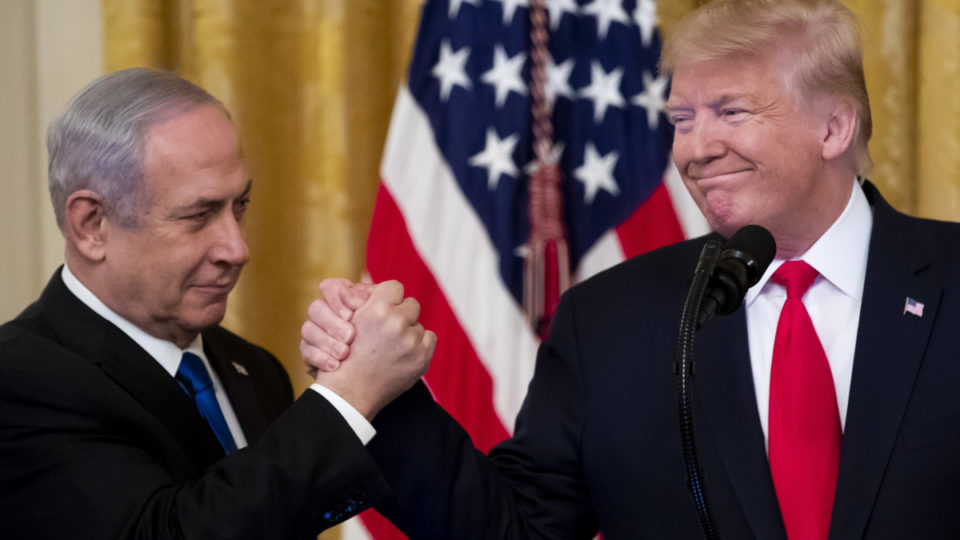
Nearly a century has passed since the beginning of the Arab-Israeli conflict, yet on 28th January 2020, two world leaders under investigation strolled into the White House to answer the seemingly impossible question of our time. ‘Trump’s Peace Plan’ was unveiled by President Trump and Prime Minister Benjamin Netanyahu, which promised a ‘two-state solution’ to the Israeli-Palestinian Conflict.
The Peace Plan recognises Israeli sovereignty over illegal settlements in the West Bank, Jerusalem and the Jordan River Valley, in total giving Israel control over 85% of Mandatory Palestine. The plan proclaims a familiar Trumpian promise of jobs, economic prosperity and dazzling infrastructure, accompanied by a demand for the demilitarization of Palestine, all written down in “the most detailed plan ever made”.
Yet international backlash to the plan has been swift, the Palestinian leadership denounced the plan even before its release, decrying it as surrender terms and accepting it would be an acceptance of an apartheid state. The plan was thrashed out by Israel and the USA, with no Palestinian input and no recognition of the lessons learnt in the past century of conflict. We will break down the key aspects of ‘Trump’s Peace Plan’ and how they will impact the region.

Borders
The nature of Israel’s borders has been a contentious topic in global politics for decades. Zionist settlements in Palestinian lands have created a grey area of where the state of Israel ends and Palestine starts, fueling violent conflict within the West Bank. The plan attempts to resolve this issue by dictating concrete borders on which the two states will function, creating a direct division between Palestinian Arabs and Israelis, reflecting the ethnocultural purity desired by a state of Israel still fuelled by Zionism. When delved into however the plan fails to consolidate the issue of borders due to illegal Israeli settlements and the continuing to neglect Palestinian claims to land they were previously forcibly removed. The plan provides no promises to the Palestinians that their land will not be further colonised by Israeli settlers and no land concessions from Israel to help create a functional Palestinian state.
The proposed borders as dictated by the peace plan shows a divided State of Palestine between Gaza and the West Bank. Not dissimilar in appearance to the apartheid system that was found in South Africa. The West Bank has a skeletal structure with large swathes of land eaten away by Israeli settlements with no return of land taken after the ‘Six-Day War’ in 1967. The plan promises Israeli sovereignty over any land containing Jewish settlements trapped within the State of Palestine, despite the UN recognition of such settlements as illegal. The wording in the plan is careful here, it very clearly states the sovereignty of such land to the Israelis but Palestine’s land trapped within Israel shall not be provided such sovereignty. This would likely fuel further conflict and provides no consolidation to the border problems.
Expansive infrastructure including a 30km tunnel between Gaza and the West Bank would connect the two arms of the Palestinian state allowing movement between the two, but beneath Israeli soil. This is in the name of Israeli security but also prevents the unification of a state of Palestine, dividing the two areas making trade and movement of people difficult. This restricts the development of Palestine, making sure it will never become powerful enough to pose a threat to Israel. Clearly the emphasis on the plan however is to create a continuous state of Israel by linking illegal settlements with the state- this would be the final move to consolidate the land as Israeli- despite historically being within Palestinian borders. It promises ‘significant territorial expansion’ for the Palestinians however fails to address overpopulation in areas such as Gaza with no concessions of land taken.
The Jordan Valley is also absorbed into the State of Israel for what the plan calls security reasons. This again isolates the West Bank from its Arab neighbour (Jordan) with Israeli controlled bridges between the two countries. This ultimately takes sovereignty away from Palestine over control of its borders. All those coming into the West Bank from Jordan will have to pass through Israeli security- this is very similar to the current military rule Israel has over the West Bank and provides little in the way of true Palestinian autonomy. Palestine will still be a state that is overseen and controlled by a separate nation-state and Trump’s plan provides few promises in contrast to this reality. Arab agricultural workers within the Valley are not promised rights to their land in the plan and will most likely be displaced in the process- just like the many Bedouin farmers that have been displaced within the state of Israel in the past few decades.
The border plan set out not only fails to address current tensions and ambiguities concerning the existence of illegal Israeli settlements on Palestinian soil but also fails to provide any kind of sovereignty and functionality to a future Palestine. In reality, it formulates a border system to hold an even tighter grip on Palestine by distancing it from its Arab neighbours and preventing any strengthening of the state.
Jerusalem
Trump’s plan states that Jerusalem will become Israel’s ‘undivided capital’. For years the holy city has been at the centre of the religious debate of the Israeli-Palestinian conflict, and Trump’s proposal all but states that the city is of more importance to Israel than to Palestine. The USA was the first country to recognise Jerusalem as the capital of Israel in 2017 and remains the only one to do so. The Israeli occupation of East Jerusalem in 1967 was ruled to be illegal by the UN, yet the status quo has endured and Israel has established de facto rule over the majority of the city.
Israel will retain control of the city’s holy sites, including Islam’s third holiest site; Al-Aqsa Mosque, they will also retain control over illegal settlements in East Jerusalem, whilst only three small, scattered neighbourhoods of Jerusalem will fall under Palestinian control, from which they are instructed to form their capital. The plan then barrels on to set out a grand economic vision for Jerusalem, promoting tourism and swathes of ‘privileges, benefits and obligations’ that must be obeyed.
The significance of Jerusalem in the Israel-Palestine question cannot be understated, the USA and Israel fail to recognise that Jerusalem is just as important to Palestine as it is to Israel, and the Palestinian leadership have regularly reiterated that Jerusalem is ‘not for sale’, it is a red line. Peace talks in the past have been derailed by the issue of Jerusalem, as both sides have not accepted anything less than complete sovereignty over Temple Mount/Haram al-Sharif. Jerusalem holds intense symbolism for the Palestinian cause, it is not only religiously significant but is a symbol of Palestinian statehood, without Jerusalem, there cannot be Palestine. The peace plan can shower the situation with promises of economic growth, jobs and access to holy sites, yet the point remains, both Israel and the USA knew that declaring Jerusalem as the capital of Israel would be simply unacceptable to Palestine.
This is the first indication that the peace plan is simply political manoeuvering on the part of the two embattled leaders of the USA and Israel. It is preposterous to assume that Palestine will simply change their mind regarding the status of Jerusalem under the guise of economic support and were the Palestinians invited to the negotiations, the relinquishment of Jerusalem would have not passed. The plan proclaims that “reciting past narratives is unproductive” and calls for a new approach to issues such as Jerusalem, yet these five words cannot eradicate, what for many Palestinians, is the single most important thing to them, which is their places of worship. Past narratives cannot be eradicated and are in fact integral in sensitive negotiations between Israel and Palestine.
Security
At the heart of the conflict has been the question of Israeli security. Were a militarized Palestinian state to exist only 10km from Tel-Aviv, accompanied by the history of conflict between Arab countries and Israel, many feel that the security of Israel would be at risk. The crux of this debate refers to the potential use of Palestine by the armies of other Arab states to launch an attack against Israel.
The peace plan details how the security of Israel would be assured, primarily through the complete demilitarization of Palestine. The plan details that Israel would maintain overriding security responsibility for the state of Palestine, only allowing Palestine to organise some of their internal security.
This proposal flies in the face of self-determination. Herein lies another crude example of a proposal that Israel and the USA know that Palestine will not accept, granting Israel control over the safety of Palestinians is a cruel display of contempt for the past treatment of Palestinians by the Israeli Defence Forces (IDF). Why would Palestinian leadership accept the protection of a state that fires indiscriminately at Palestinians protestors in Gaza, has a history of population transfer and ethnic cleansing dating back to the 1940s? Despite calling the plan a ‘two-state solution’, it is clear that one state would maintain significant power to repress the other.
The map of a future Palestine shows it becoming an enclave within Israel, as its border with Jordan is severed in order to grant Israel sovereignty over the Jordan River Valley. The valley cuts a future Palestine off from its Arab neighbour and is argued to be critical to Israeli security, yet is home to the majority of Palestinian agriculture. To exit Palestine, Palestinians must first pass through Israel to gain access to its neighbours.
The demarcation encircles Palestine in Israel, coupled with Israeli military dominance over Palestine, this further establishes the state as subordinate and under the thumb of Israel. One must also consider whether the Jordan River Valley is essential to Israeli security, whilst the peace plan talks on one hand that “reciting past narratives is unproductive”, the past narrative that all of Israel’s neighbours are seeking their imminent annihilation is misguided. Having reached peace agreements with Egypt and Jordan in 1978 and 1994 respectively, the threat of advancing Arab armies across the valley into Palestine is almost non-existent. It is illogical to assume that Arab states have the means and desire to invade Israel in the 21st Century, with American guarantees of independence and the lack of Arab military capabilities rendering this unattainable.
The annexation of the valley, therefore, is merely an attempt to maintain a tight leash on a future Palestinian state, wherein which Israel can control the exports and movement of people in and out of Palestine whilst maintaining military dominance over Palestine. This is at the expense of Palestinian agriculture, which the deal claims to guarantee by encouraging Israeli-Palestinian agreements for licensing and permission to farm, however this process would be under Israeli control and potential for abuse would be high.
Refugees
The Palestinian refugee crisis is the single biggest issue that has arisen due to the ethnic cleansing carried out by Israel starting in 1948 and continuing to this day. There are currently 7.2 million recognised Palestinian refugees worldwide with many living in large scale refugee camps not only in neighbouring countries to Israel such as Jordan but also within Gaza and the West Bank. The fate of these refugees has been one that Israel has failed to provide an answer for, this peace plan proposes a meagre solution to the problem.
The plan first and foremost states that there will be ‘no right to return’ to Israel for any Palestinian refugees. In other words, Israel will accept no responsibility for the refugee crisis that it has caused, providing no monetary support for refugees as well. It goes on to conflate Palestinian refugees with Jews that have moved to Israel from Arab countries- stating that there have been an equal number of both. This not only fails to demonstrate the gravity of the Palestinian refugee problem but distastefully likens Jewish Zionism with Palestinian displacement through forceful ethnic cleansing. After the agreement to the plan from Palestine it states that all Palestinian refugees will have their refugee status rescinded, this deals with the problem on a purely semantic level, helping Israel’s global image.
Palestinian refugees will instead have to move to the West Bank or already overcrowded camps in Gaza. This new state of Palestine will be under-resourced and overpopulated to receive such a large amount of refugees, unlike the economically prospering state of Israel. The Trump Economic Plan promises aid for this acceptance of refugees by Palestine but lack of current infrastructure and border limitations will make the acceptance of so many refugees an almost impossible task. Any Palestinian refugees moving to Palestine from countries deemed a security risk by Israel such as Syria and Libya could also be denied access to the state, once again preventing Palestine from holding true sovereignty.
The plan also pushes for Arab countries currently harbouring Palestinian refugees to allow for them to settle, placing blame on countries such a Lebanon for fueling the refugee issue rather than Israel accepting any blame. It accuses Lebanon of not providing sufficient rights to Palestinian refugees and preventing them from integrating into society. This ironically mirrors the plight of Palestinians living within the state of Israel where they are unable to buy land in over 75% of the country. This blame placed on Arab countries alleviates the blame placed upon Israel and means they can push for further concessions from Arab countries such as the demands for compensation for Jewish refugees that Israel states have been pushed out of Arab countries due to tensions from Arab-Israeli conflict.
Conclusion
The peace plan set out at The White House is an insult to the century of plight endured by Palestinians, offering nothing more than a puppet state to those who have fought for so much more. Whilst practically possible, it disregards every red line that ever drawn by the Palestinian leadership, offering them protection by a state that has persecuted them for a century.
The timing of the announcement seems to be no coincidence, with Netenyahu facing corruption charges and an uphill battle towards reelection in Israel, and Trump enduring impeachments trials in the USA. It is a feeble attempt to score political points in a time of personal crisis for these two leaders.
Furthermore, the plan portrays an Israeli message that it is unwilling to concede any land taken in previous wars or colonisation attempts, flying directly in the face of Palestinian sovereignty and international law. They desire a Palestine that they are able to control, monitor and eventually dominate, further cementing the narrative that Palestinians have not and will never be welcome in an Israeli state.
Written by Jack Ainsworth and Matthew Cockrell



Average Rating